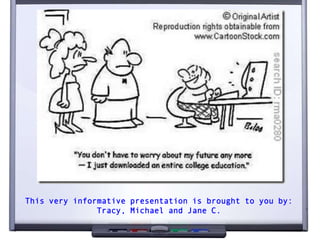
Differences in Online and Blended Learning Environments
- 1. This very informative presentation is brought to you by: Tracy, Michael and Jane C.
- 2. Does learning take place differently in online and blended learning environments? http://freestockphotosonline.blogspot.ca/2012/09/stock-images-guessing-image-2722784.html
- 4. Constructivist like Piaget, suggest that learning and development occur when children interact with the environment and the people around them (assimilation). Hands on learning, allows the new information experienced to be combined with the information that they already know (accommodation). Students can construct knowledge by combining the new information with the behaviour and the skills they have previously learned. Learners are adapting to the world through assimilation and accommodation (Atherton, 2010). http://www.digitalwish.com/prod_images/SB690_box_full.jpg
- 5. Student engagement in an online learning environment can present itself in many forms: Participation in online discussions. Creating evidence of learning. Asking meaningful questions. Exploring the online world to expand knowledge. http://resources0.news.com.au/images/2011/02/10/1226003/732800-computer-kid.jpg
- 6. Student engagement in a blended learning environment can present itself in many forms: Participation in online discussions and f2f. Creating evidence of learning both online and f2f. Asking meaningful questions online and f2f. Exploring the online world to expand knowledge. http://www.securedgenetworks.com/Portals/80068/images/iballz_in_the_class_large.jpg
- 7. “There is evidence that touching behaviors can actually increase learning.” (Kleinfeld) One recent investigation has shown that teachers that employed such behaviors as smiling, touching, and close body proximity, children “tended to learn significantly more.” (Kleinfeld) http://www.hrepic.com/Teaching/GenEducation/nonverbcom/nonverbcom.htm
- 8. Resources for a blended learning environment come in many forms: Guided access to resource. Access to resources from anywhere in the world. Access to resources at any time of the day. Peer to peer sharing of resources. Access to open text books.
- 9. Resources for an online learning environment come in many forms: Guided access to resources. Easy access to resources. Access to resources from anywhere in the world. Access to resources at any time of the day. Peer to peer sharing of resources. Access to open text books. https://mail-attachment.googleusercontent.com/attachment/u/0/?ui=2&ik=a92fedc209&view=att&th=13af1b53febe0982&attid=0.1&disp=inline&safe=1&zw&saduie=AG9B_P_4QDVOgp3QYus_maThe7ii&sadet=1352693255018&sads=3joBs6gDpMNb1uaWaulRsYF1sAU&sadssc=1
- 10. Social rein forcers consist of words, gestures, and facial expressions. Many students work diligently just to get a smile, pat, or a kind word from the teacher. Some examples are: Verbal: OK. Wow! Excellent. Nice going. Exactly. Right. Thank you. I like that. Would you share that? Nonverbal: Smiles, winks, eye contact, nods, thumbs up, touches, pats. walk beside, stand near, shake hands.
- 11. Student individualization in an online learning environment can be attained through: Peer and instructor interaction and guidance through collaborate and/or skype. Finding online tools and information that enhance learning style. One to one online help with the instructor through skype and other interactive medium.
- 12. Student individualization in a blended learning environment can be attained through: Peer and instructor small group interaction Finding online and concrete tools to enhance learning style One on one physical presence guidance with instructor
- 14. Our Conclusions and Questions… Learning takes place very similarly in both the online and blended environments. Where the two diverge and differ is the absence of physical presence and touch. What could this mean for learning at the different age groups for online learning?
- 15. Does physical contact affect online and blended learning environments? https://mail-attachment.googleusercontent.com/attachment/u/0/?ui=2&ik=a92fedc209&view=att&th=13af1c77be7f8d00&attid=0.1&disp=inline&safe=1&zw&saduie=AG9B_P_4QDVOgp3QYus_maThe7ii&sadet=1352693271303&sads=_zgivlbi9a1gt2LvsBNbd2PjVDc